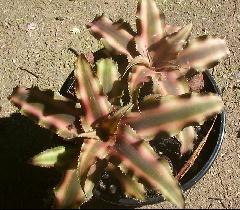
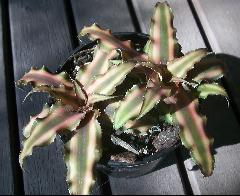
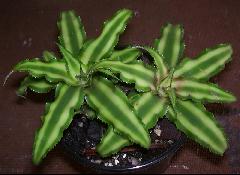
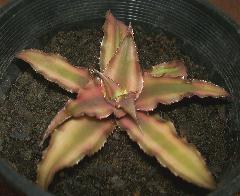
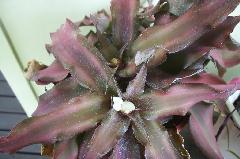
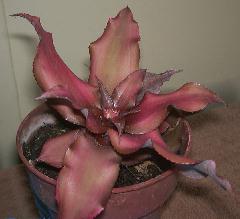
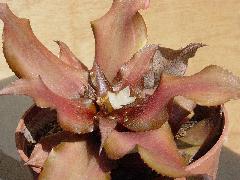
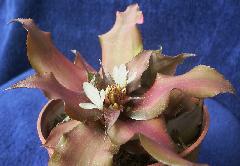
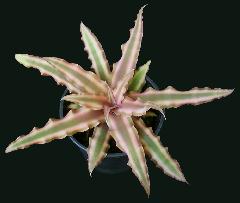
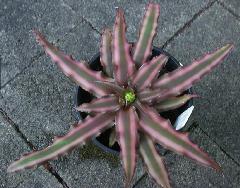
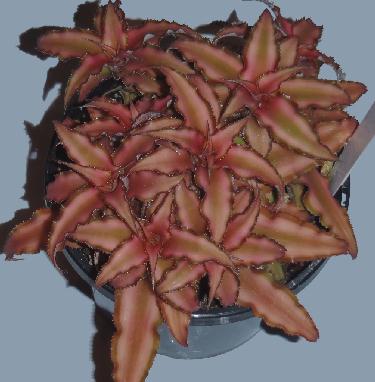
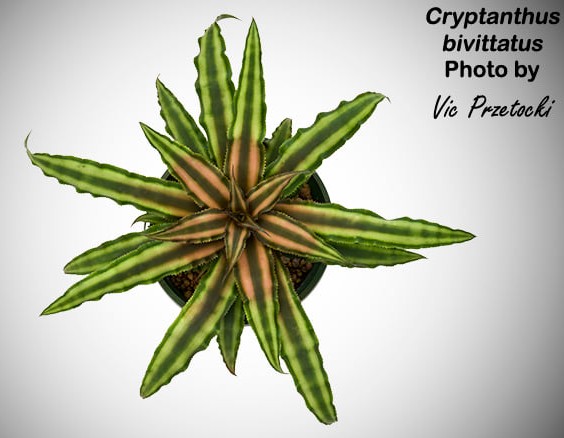
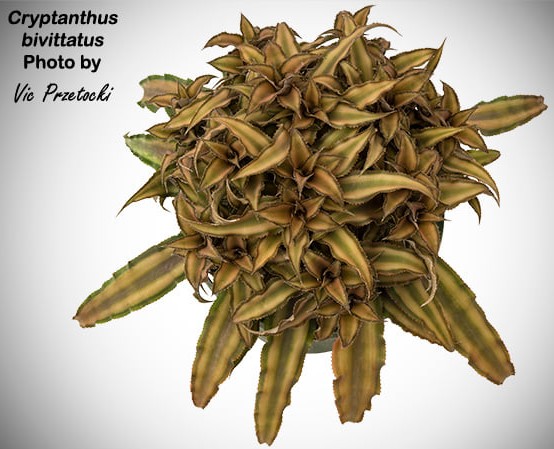
Cryptanthus bivittatus var. bivittatus
Billbergia bivittata Hooker, Bot. Mag. 87: pI. 5270. 1861.
Tillandsia bivittata hort. Linden ex Regel, Ind. Sem. Hort. Petrop. for 1864. 15. 1865; nomen in synon.
Nidularium bivittatum Baker, Handb. Bromel. 16. 1889; nomen.
Tillandsia vittata hortus ex Baker, Handb. Bromel. 16. 1889; nomen.
Cryptanthus bivittatus var luddemannii Baker, Handb. Bromel. 16. 1889. Type. Morren Icon (K). = now marginatus
Cryptanthus bivittatus var moensis hortus in Cat. Brom. Hort. Lugd.Bat. 1894; Mez, DC. Monogr. Phan. 9: 57. 1896.
Cryptanthus moensi hortus ex Gentil, Pl. Cult. Serres Brux. 66. 1970; nomen (fide W. Robyns).
Leaves green except for the pale stripes of color.
Type. Hortus Kew ex Hortus Linden s n (holotype K), South America.
Distribution. Undoubtedly from Brazil but known only from cultivation.
BRAZIL: Cultivation: Atkinson 60 (GH, US); Foster 1192 (GH).
Cryptanthus bivittatus var atropurpureus Mez, Pflanzenreich IV. 32: 18. 1934.
Cryptanthus atropurpureus Hortus Edinburg ex Mez, Pflanzenreich IV. 32: 18. 1934; nomen.
Leaves suffused with red in addition to the stripes.
Type. No material found, variety typified by original description.
Distribution. Indefinite, Brazil. Known only from cultivation and no known live or herbarium material remaining.
From Mez 1935
var. atropurpureus Mez var. nov.
C. atropurpureus Hort. Edinb. ined.
A typo evidenter differt omnibus partibus satis minoribus. Folia constanter rubra sub sole purpurascentia minus insigniter bivittata, vix ultra 50 mm longa et 15 mm lata.
Nur kultiviert bekannt.
Translated by Butcher
Evidently different to type with all parts sufficiently smaller. Leaves uniformly red or solely purplish with less remarkable double stripes, barely more than 50mm long and 15mm wide.
Butcher's comment June 2011 - Even though there is a difference between Smith's description and that of Mez the varietal status does not seem warranted and this should be treated as synonymous with the Type. While Luther agreed to the move of transferring C. var. luddemannii to C. marginatus nothing was done with var. atropurpureus.
From Cryptanthus Soc Journal 1(4): 10-14. 1986
Reprinted from Botanical Magazine, September 1861, England. Sir W. Hooker, author/editor.
Plate page 9- Cryptanthus bivittatus, original herbarium specimen: composite taxonomic drawings and holotype: Bilbergia bivittata (Hook), Regal. Photo courtesy National Museum of Natural History, Smithsonian Institution. (Thanks to Dr. Robert W. Read for his assistance in obtaining the photograph)
TAB 5270. BILLBERGIA BIVITTATA
Ribbanded Billbergia
Nat. Ord. Bromeliaceae -----Hexandria Monogynia
Gen Char Perigoni superi sexpartiti laciniae exteriores calysinae, aequales, escarinatae, erectae vel spiraliter convolutae, aristatae vel muticae, apice hine oblique dilatatae, Interiores petaloidae, exterioribus multo longiores, apice patentes v. erectae, intus basi squamosae v. biaristatae, rarius nudae. Stamina 6, epigyna; filamenta filiformia, tria plerumque perigonii laciniis interioribus adnata; antherae ovatae, dorso affixae, incumbentes v. suberectae. Ovarium inferum, trioculare. Ovula plurima, c loculorum angulo centrali pendula, anatropa. Stylus filiformis; stigmata 3, petaloides, convoluta v. linearia, crispa, Bacca subglobosa, trilocularis. Semina plura, nuda vel ad umbilicum filo gracili appendiculata, ---Herbae Americanae tropicae, saepius superarborum truncis pseudo-parasiticae, excapae vel scapigerae; foliis ligulatis, linearibus vel ensiformibus, ut plurium spinuloso-serrulatis; floribus spicatis, paniculatis vel racemoso-paniculatis; spathis floralibus nunc marginis, nunc parvis vel amplis, coloratis. Endl.
BILLBERGIA bivittata; acaulis, foliis corisceis firmis lanceolatis acuminutissimis argute serrutis undulatis fusco-viridibus lineis duabus albo-vittatis, spien inter folia sessili, floribus albis, petulis calycinis imbricatis mucronatis, corallinis spathulatis.
BILLBERGIA vittata, Linden Cat.
This pretty plant came to us under the name of Billbergia vittata, from Linden, in 1859. It is certainly not the plant of that name described by Beer in his review of the Order, nor is it the B. Moreliana vera of Lemaire's 'Jardin Fleuriste,' and Paxton's 'Flower Garden,' both of which Beer quotes under vittata. it is evidently a near ally of Tillandsia acaulis, Lindl. (Bot, Reg. t. 1157); but as the calyx is distinctly superior, it cannot be referred to that genus as characterized in Endlicher.
Probably it should be referred to Beer's genus Chryptanthus, of which no generic characters have been published by that author. It is, no doubt, a native of South America, but we are not aware of its exact country.
DESCR. Plant almost stemless. Leaves closely set just above the root, spreading, recurved, about a span long, and one to one and a half inch broad, rather undulate, acutely toothed at the margin, under surface dull brown, upper green, with two broad, buff, longitudinal bands, which pass into dull red at the base of the leaf. Flowers collected into a short dense spike, which is wholly sunk amongst the leaves, white. Bract oblong, lanceolate, acute. Perianth superior. Calyx of three cuneate segments, each obliquely expanded, and mucronate at the apex.
Corolla of three, white spreading, spathulate lobes. Stamens six, three attached to the petals, short with sterile(?) anthers in the pistillate flowers, Pistil absent in some flowers; where present filiform, expanding into three patent lobes.
One goal of the Cryptanthus Society is to help members identify their plants by researching available documentation and making it available through the Journal. Acquiring documentation on Cryptanthus bivittatus {bi-vit-ta-tus} seemed like an easy task...it's probably the most common Cryptanthus. The plant was described in 1861 and we all have 'minor'; 'major'; 'luddemannii'; or the cultivars 'Starlight'; 'Pink Starlight'; and 'Ruby':
OR DO WE?
I began my research with Dr. Lyman B. Smith's and Robert Jack Downs Flora Neotropica. Monograph No.14, Part 3, Bromelioideae, described only C. bivittatus var. bivittatus and C. bivittatus var. atropurpureus (same as bivittatus but the leaves suffused with red). I was confused. I was sure Dr. Smith was describing "minor" but what happened to the other forms with which I was familiar. I called several knowledgable growers and asked them to describe "major;' "luddemannii;' and atropurpureus to me. Each person I contacted described the same three plants, but each was called by a different name. What I called "luddemannii': one person called "major': what I had labeled 'major' another called atropurpureus. Still another thought atropurpureus was 'Ruby': {And we thought we were going to have trouble with the hybrids}.
My next step was to check the Cumulative Index to the Bulletin and the Journal of the Bromeliad Society. Each time I looked up the reference listed for C. bivittatus, it was usually a show report listing the plants in an affiliate society display. No help. The only reference to "luddemannii" was in Volume 21 of the Bromeliad Society Journal. I didn't have the issue, so I call Georgia Waggoner, CS Research Committee Chairman, to send me a Xerox copy of the referenced page. You guessed it - a society display plant listing. Researching documentation on C. bivittatus was obviously going to take a lot more effort than I had anticipated.
BACK TO SQUARE ONE.
Dr. Smith referred me to Dr. Robert Read, Curator, Department of Botany at the National Museum of Natural History at the Smithsonian Institution, Washington DC. He was happy to send any documentation he had available, but he does not specialize in Cryptanthus. He suggested I contact Dr. Gustavo Martinelli at the Jardim Botanico, Rio de Janeiro, Brazil. Upon contacting Dr. Martinelli, he said 'minor' and 'major' were not valid variety names since they had not been published as such. Due to the impending destruction of habitat, he was concentrating his work on C. acaulis and C. bromelioides but had visited the natural location of C. bivittatus var. bivittatus in Santa Teresa, Espirito Santo in July and the area was destroyed.
The only plants remaining are those in private collections and botanical gardens.
PURSUING THE CULTIVARS.
I called the nursery of Paul De Coster in Belgium as I had heard he was responsible for developing the bivittatus cultivar 'Pink Starlight': I talked with his son Ghierry and asked for any documentation he or his father might be able to provide on Cryptanthus. Later in the day, I mailed the latest copy of the Journal of the Cryptanthus Society and a letter restating my conversation.
About a week later I received not just a letter from Paul De Coster, but an entire package of all the documentation he had on Cryptanthus. 'Pink Starlight' is a sport of C. bivittatus and is patented by Barnell L. "Larry" Cobia, of B. L. Cobia, Inc., of Winter Garden, Florida, USA. The variety was found at the same time by Paul De Coster in the Netherlands. In Europe, it was given the name 'Coster's Favorite’ and according to De Coster there was and still is a slight difference in the degree of undulation between the one found in the United States and the De Coster variety. Cobia had his variety "fingerprinted" by Dr. "Al" Miller, botanist and Dr. Roseann White, bio-chemist at the University of Central Florida, Orlando. Fingerprinting is a two-dimensional map of the plant flavonoids, or a chromatogram, from which the plant molecules can be identified for comparison. Through a gentleman's agreement between Cobia and De Coster, the patented name 'Pink Starlight' is used for all plants sold in the United States.
Mark Cobia, Executive Director of Research and Development for B.L. Cobia, Inc. supplied information on the development of C. bivittatus 'Starlight' and 'Pink Starlight':
Cryptanthus 'Starlight' first appeared in Florida in 1978 as a mutation from Cryptanthus bivittatus, known in the trade at the time as {roseus-pictus or rosea-picta). The mutation was uniform from the beginning so that development time was minimal. The variety is not patented.
Cryptanthus 'Pink Starlight' is also a vegetative mutation. However, the mutation was not uniform and development time was considerably longer. The mutation originally showed up as a very thin albino (pink) margin on one side of one leaf of a C. bivittatus. At that point, it was only a matter of time until a sucker with a uniform pattern was produced. Total development time for 'Pink Starlight' was approximately eleven years.
The patent was issued in 1975 (#3689).
In 1981, B. L. Cobia, Inc. purchased all the stock of Cryptanthus 'Ruby' from a central Florida nursery that was in liquidation. Its origin beyond that point is unknown.
Additional research indicated that about 300 'Ruby's had come from Tri Tiki Nursery in Winter Garden, Florida. According to CS Director, Cornelius Collin the owner of the nursery was Don Biggers. The nursery closed when Biggers was found murdered in his boat house. The case was never solved. At this time we cannot be sure if 'Ruby' is a C. bivittatus sport or if the plant is Cryptanthus bivitattus var. atropurpureus. We won't know for certain until someone is able to trace where Don Biggers got his original plants. It sure sounds like a good job for someone in the Florida area. Bob Whitman brought a plant from Brazil supposed to be C. atropurpureus. Under southeast Texas growing conditions, however, all C. bivittatus appear suffused with red. When this "C. atropurpureus" blooms, I will send it to the Mulford B. Foster Bromeliad Identification Center for evaluation.
DOCUMENTATION ARRIVES FROM THE SMITHSONIAN INSTITUTION.
Dr. Read had included a photo of the original plant and taxonomic drawings from which bivittatus was described. He also sent the photo of Morren's drawing of var. luddemannii. Var. luddemannii had been described by J. G. Baker in the Handbook of the Bromeliaceae in 1889. As first assistant in the herbarium of the Royal Gardens at Kew, England, he stated the "habitat to be Brazil and introduced by Linden from Portu Seguro. In cultivation at Kew since 1859 it first flowered in 1861. The variety was described from a drawing by Professor Morren - more robust than the type, leaves 2 inches broad, much tinged with brown, and the two vertical vittae almost or quite confluent into a broad band occupying more than half the center of the face of the blade:"
I phoned Dr. Lyman Smith to ask him why the larger, more robust "luddemanii" was not included with C. bivittatus in his monograph. He explained that there are large and small forms in most species and they are not considered separate taxonomically. Furthermore, there was no holotype (the original specimen from which the description is made) to study. Hence, Dr. Smith could only describe two forms in his monograph.
CONCLUSION:
By definition, all C. bivittatus material in cultivation is var. atropurpureus because it is all reddish. Harry Luther's feeling is that all material is derived from one clone. There is nothing known about the population in the wild. Atropurpureus, from a biological standpoint, should be synonymized under C. bivittatus. Most cryptanthus appear in reddish colored and green leaf mixed populations. There is probably only one gene different, which doesn't make for a separate variety. A variety should have some sort of geographic correlation or some other reason for being considered different, other than minor variation in foliage color. The four plants pictured on the cover of the Journal are Cryptanthus bivittatus and its cultivars, 'Starlight', 'Pink Starlight' and 'Ruby'. These are the only representatives of the species.
One of the more popular bromeliads is Cryptanthus bivittatus. First described in 1861, and redescribed by botanists in 1861 as Billbergia bivittata, in 1864 as Tillandsia bivittata, in 1889 as Nidularium bivittatum, and in 1907 as Cryptanthus moensi, it is unfortunate that this Cryptanthus from Southern Brazil is probably now extinct in the wild.
There have been numerous varieties and cultivars in the trade in the past with such names as C. b. 'bivittattus', C. b. "var. minor", C. b. var "major", C. b. "var. luddemannii", C. b. var. atropurpureus, C. b. 'Grande’, and C. b. 'Green luddemannii'. To add to the confusion, common names like 'Rose-stripe Star', 'Dwarf Rose-stripe Star', 'Rosea Pictus' and 'Roseus' have been used synonymously.
Most references to Cryptanthus bivittatus prior to 1986 identified three varieties as generally accepted: C. b. var. bivittatus or C. b. "var. minor":, C. b. var. luddemannii or C. b. "var. major", and C. b. var. atropurpureus.
C. b. "var minor", the smallest of the types, was first described as a small rosette with about 20 six-inch green tooth-edged leaf blades. As the name denoted, there are two pale vertical bands of yellow or cream. C. b. var. atropurpureus is distinguished by leaves which are diffused with red.
In 1986, Warren Loose, after extensive research, was unable to find any C. bivittatus var. bivittatus which did not have reddish coloration. As mentioned earlier, the plant's original location in Brazil has been destroyed, making it impossible to examine the original plant. It is his conclusion, based on color descriptions, that all C. bivittatus in cultivation are C. b. var. atropurpureus. This opinion is also shared by Harry Luther. It is his view that all C. b. var. bivittatus plants now in cultivation were derived from one clone of C. bivittatus var. atropurpureus which differs from the originally described C. bivittatus var. bivittatus by one gene determining the red coloration. Based on these theories, some day a mutation of this red gene may bring back into cultivation the long lost C. bivittatus var. bivittatus
Warren Loose uncovered another mystery during his research of C. bivittatus "var. luddemannii". This variety of C. bivittatus was generally accepted since its description in 1889 as just a large variety of C. bivittatus. With much footwork, Warren confirmed his suspicions with studies of Harry Luther that C. bivittatus "var. luddemannii" was actually Cryptanthus marginatus, a larger, similarly striped plant, but definitely a separate species and not a variety of C. bivittatus.
These findings have considerably simplified our understanding of C. bivittatus. First, based on the original description of C. bivittatus var. bivittatus and C. bivittatus var. atropurpureus, and on general observations of the presence of red in all C. bivittatus now in cultivation, we can conclude that C. b. var. atropurpureus as the true variety we have in our collections and therefore C. b. var. atropurpureus should be used synonymously with C. b. var. bivittatus due to their minimal genetic differences. Furthermore, there is no C. b. bivittatus "var. luddemannii" or C. b. "var. major". This is a separate species Cryptanthus marginatus.
Nature, with the help of dedicated horticulturists, has rewarded our efforts to keep alive C. bivittatus the species by providing us with several cultivars probably more interesting than their ancestors.
First seen in Florida in 1978, Cryptanthus 'Starlight' occurred as a sport of C. bivittatus. The border stripes of olive-green remain, but the inner stripes from outward to the center of the leaf blade changes from cream to light pink, to dark pink with faint olive-green central stripes mimicking those in the parent plant from which it mutated. Fortunately, the overall colors and pattern were uniform which allowed the quick establishment of C. 'Starlight' as a favorite of many. No one has accepted credit for introducing this mutation and it remains unpatented.
The story of the development of Cryptanthus 'Pink Starlight' is one of foresight and commercialism. At nearly the same time Paul DeCoster in Belgium and Barnell Cobia in Florida produced vegetative mutations of C. bivittatus having similar characteristics. After eleven years of work, Cobia perfected a uniform pattern. Cornelius Colin provided me with an intermediate form from which the current patented C. 'Pink Starlight' was developed. In my C. bivittatus, some of the leaves have the green outer stripe on one side of the leaves replaced by a pink stripe. In 1975 the uniform plant with wide light pink stripes bordering each leaf was patented by Cobia to allow for commercial sales in the United States. The European version distributed by DeCoster was called C. 'Coster's Favorite'. This Cryptanthus differs in the extent of undulation of the leaves.
Fortunately the two developers have agreed to keep the patented name C. 'Pink Starlight' for all sales of this mutation in the United States.
The third of the known cultivars of C. bivittatus is Cryptanthus 'Ruby'. Grown in good light this plant has two colors: ruby red and dark green. Resembling C. bivittatus var. atropurpureus in size and shape, the paler area between its central, and two lateral green stripes are nearly solid red rather than simply diffused with red. If you accept the early premise that the C. bivittatus currently in cultivation is C. bivittatus var. atropurpureus, it is easier to accept Cryptanthus 'Ruby' as a sport of it.
The small size, ease of adapting to a variety of growing conditions, diversity of colors, and profuse pupping of C. bivittatus and its cultivars make them the perfect bromeliad for the collector and for use in displays.